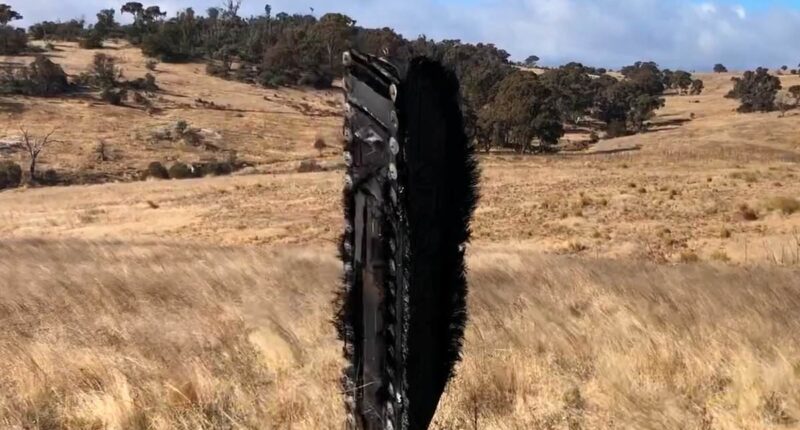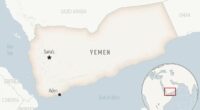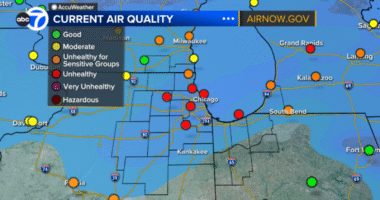Shortly before Christmas, a weather satellite from the US Air Force broke apart into 50 fragments, marking one of approximately four recent incidents of objects breaking up in space that have raised concerns about what experts call ‘Kessler Syndrome.’
Named after American astrophysicist Donald Kessler, who first highlighted its risks in 1978, Kessler Syndrome refers to a scenario where collisions between objects in orbit trigger a chain reaction of destruction, escalating the issue of space debris.
The space debris consists of various fragments, including pieces of defunct satellites, components of booster rockets, remnants from weapon experiments, and even small items like a loose screw from a spacecraft, all contributing to the staggering count of over 130 million debris items currently encircling the Earth.
Only about 40,500 pieces of that debris are greater than four inches, according to the European Space Agency (ESA). The vast majority is between 0.4 to 0.04 inches long.
But most of this ‘space junk’ is moving extremely fast, buzzing Earth at around 18,000 mph or nearly seven times faster than a speeding bullet, according to NASA.
While only 650 major collision accidents have been reported since 1957, ‘the number of objects in space that we have launched in the last four years has increased exponentially,’ according to planetary scientist Vishnu Reddy.
‘We are heading towards the situation that we are always dreading,’ Reddy warned.
‘Unless we do something, we are in imminent danger of making a whole part of our Earth environment unusable,’ Dan Baker, the director of the University of Colorado’s Atmospheric and Space Physics lab, warned during a conference this December.

Named after astrophysicist Donald Kessler – who first warned of its risks in 1978 – Kessler Syndrome basically describes a ‘space junk’ chain reaction, in which hardware smashing into each other in orbit creates runaway destruction. Above: a NASA map of known space junk

LeoLabs estimated that a December 19, 2024 ‘fragmentation’ of a US Air Force weather satellite introduced 50 new pieces of space junk into orbit. There is now over 30,000 pieces of space junk circling Earth – posing major risks of a ‘Kessler Syndrome’ event
‘We have to get serious about this,’ Baker told his fellow scientists attending the conference, held by the American Geophysical Union (AGU) in Washington DC .
The frequency of space launches has skyrocketed this decade, fueled by the rise of private space firms and a new race to the moon, with an average of 82 launches annually from 2008 to 2017 climbing to 133 launches-per-year from 2018 onward.
Right now, in low-Earth orbit (LEO), about 1,000 collision warnings are issued daily to alert telecoms, governments, scientists and others about the risks to their hardware.
These alerts, issued by the US Space Force, happen to reside at the orbital altitude where Elon Musk has launched over 7,000 of SpaceX’s Starlink internet satellites.
‘It’s getting difficult for satellite operators to determine which of these warnings is important,’ solar physicist Thomas Berger said, ‘which they have to pay attention to.’
But according to Reddy, a professor at the University of Arizona in Tucson, the risk of catastrophic space junk is worse at higher and more stable ‘geosynchronous orbits.’
Named because satellites at this altitude hover over one location back on Earth, orbiting in unison with the planet’s own spin, geosynchronous orbit (GEO) is home to billions of dollars worth of government and private communications satellites.
Critical systems including the National Oceanic and Atmospheric Administration’s (NOAA’s) weather-tracking GOES satellites, Pentagon spy platforms, DirectTV and SiriusXM satellite radio all operate in GEO about 22,236 miles out in space.
‘The most dangerous place where this [a ‘Kessler Syndrome’ event] could happen is in GEO,’ Reddy told CNN. ‘Because we have no way of cleaning it up in a quick way.’

A two-pound cylinder from a NASA battery pallet (pictured) released by the International Space Station in 2021 crashed into a man’s home in Naples, Florida three years later – in April of this year. The episode is only one dramatic example of the risks posed by space junk

Ex-NASA physicist Sierra Solter-Hunt has warned that cheap satellite ‘megaconstellations’ like Elon Musk’s Starlink could disrupt Earth’s magnetosphere – exposing all life to deadly cosmic rays. She’s called for more studies on ‘the accumulation of metal dust from the space industry’
While debris in lower orbits, like LEO, will naturally fall back to Earth and often burn up harmlessly in time, unwanted and dangerous trash in GEO can remain in orbit literally for millennia — increasing the risk of dangerous high-speed collisions in that orbit.
Currently, the US military is tracking approximately 47,000 individual objects in orbit, much of it space junk at about twice the volume of what was up there a decade ago.
Worse, a chief scientist for the ‘space situational awareness’ tracker COMSPOC, Dan Oltrogge, said these figures were almost guaranteed to be underestimates.
‘What keeps me up,’ according to Oltrogge, the director of COMSPOC’s Center for Space Standards and Innovation, ‘is that the data is not accurate enough to allow you to actually avoid the thing you think you’re avoiding.’
Some also fear that the onset of ‘Kessler Syndrome’ might be a slow-motion train wreck, one where the orbital billiard balls are already in motion, even if humanity somehow halted all of its space programs, public and private, foreign and domestic.
Kessler’s original 1978 thought experiment proposed a scenario where the current inertia of space junk collisions, perhaps too tiny to be tracked from Earth today, are slowly building momentum — adding more and more projectile debris into the system.
‘If the Kessler syndrome starts to happen and we start to see a sort of cascade of collisions, we’re going to see it in the smallest grains first,’ space plasma physicist David Malaspina told this December’s AGU meeting in DC.
‘These are our canary in the coal mine,’ Malaspina, an assistant professor at the University of Colorado, advised.

Solter-Hunt drew on estimates that Musk’s SpaceX is currently burning up over 2,755 lbs (1.3 tons) of internet satellite debris in Earth’s atmosphere every hour, creating a metal layer of ‘conductive particulate’ in orbit. Thousands of Starlink satellites are now above Earth

Large pieces of a SpaceX Crew-1 ship were also found in a field in Australia in 2022. This frayed piece of crash debris (pictured) shows its exposed carbon fiber and studded metal bolts
This time last year, ex-NASA physicist Sierra Solter-Hunt warned that future metallic debris fields from cheap satellite ‘megaconstellations’ like Elon Musk’s Starlink could disrupt Earth’s magnetosphere exposing all life to deadly cosmic rays.
Solter-Hunt’s study, posted to Cornell’s arXiv in December of 2023, drew on estimates that Musk’s SpaceX is allowing over 2,755 lbs (1.3 tons) of wireless internet satellite debris to incinerate into burnt metal dust in Earth’s atmosphere every hour — creating a metal layer of ‘conductive particulate’ in orbit.
‘I was very surprised,’ physicist Solter-Hunt told DailyMail.com. ‘No one has given much research to the accumulation of metal dust from the space industry.’
Particles from these satellites at the end of their lifecycle could ‘distort or trap the magnetic field’ that keeps Earth’s atmosphere from escaping, the physicist said, ‘with all of the highly-conductive metal trash that is all settling in one region.’
The results would be apocalyptic, leading Earth to the kind of ‘atmospheric stripping’ that turned ancient Mars and Mercury into the lifeless wastelands they are today, although Solter-Hunt noted that this outcome would be an ‘extreme case.’
After working on NASA’s comet-catching Stardust spacecraft research team in 2012, Solter-Hunt spent three years at the US Air Force Research Laboratory.
There she studied the electromagnetic behavior of plasma plumes in low-Earth orbit (LEO), the region of the upper-atmosphere where Starlink’s orbital network resides. She now consults on space weather for the aerospace industry.
‘We are at about 10,000 satellites [in orbit] right now, but in 10 to 15 years there are likely going to be 100,000,’ Solter-Hunt told DailyMail.com.
‘By the time we get to 100,000 I think it could be too late,’ she said, ‘in terms of this unplanned geoengineering experiment that is going to occur.’

There are more than an estimated 130 million pieces of so-called ‘space junk,’ in orbit according to the European Space Agency, but only tens of thousands are tracked (pictured)

Above: a debris field created by the November 2021 Russian anti-satellite test against Russia’s own Cosmos 1408, which alarmed the astronauts, satellite operators, and spacefaring nations
But SpaceX is only magnifying trends that date back to the earliest days of the Cold War space race, beginning when the Soviets first launch Sputnik on October 4, 1957.
Since then, according to the European Space Agency, there have been more than 650 documented case in which man-made space platforms have suffered ‘break-ups, explosions, collisions, or anomalous events resulting in fragmentation.’
Speaking at the AGU meeting, UC-Boulder physicist Dan Baker compared what has happened to the economic condition known as ‘the tragedy of the commons.’
‘Stated simply, the tragedy of the commons is that individuals acting rationally and individually according to their own self interest will deplete a shared resource, even if this is contrary to the best interests of the group,’ Baker said.
‘And I believe that we are watching the tragedy of the commons play out in low Earth orbit right before our eyes,’ he told the AGU, according to Space.com.
Reddy, the planetary scientist at the University of Arizona, agreed — hoping that industry, government actors and international agreements might finally reign everyone in.
‘I think the biggest concern is the lack of regulation,’ he said. ‘I think having some norms and guidelines that [are] put forward by the industry will help a lot.’

















